Abstract
Compound muscle action potentials (CMAPs) of the lingual muscles were recorded by especially devised bipolar surface electrodes placed on the tongue. Distinct responses were evoked in the tongue muscles by peripheral electrical stimulation of the hypoglossal nerve medial to the angle of the jaw and by transcranial magnetic stimulation of the motor cortex. With cortical stimulation during voluntary activation of the tongue muscles it proved easy to obtain responses with the characteristics of centrally evoked responses allowing reliable measurements of latencies and amplitudes. By contrast, responses from magnetic stimulation of the intracranial segment of the hypoglossal nerve were more difficult to obtain and the reproducibility was often not satisfactory. In a group of 20 healthy subjects the average distal motor latency of both sides from peripheral stimulation was 2.4 ms and the corresponding amplitude was 9.3 mV on the left and 8.6 mV on the right side (range 5.1-16.0 mV). Cortical stimulation gave responses with an average onset latency of 8.6 ms and 8.8 ms and an average amplitude of 1.8 mV and 2.6 mV on the left and right sides of the tongue respectively (range 0.7-5.6 mV). From this mean conduction times of 6.2 ms on the left and 6.4 ms on the right side (SD 1.0 ms) between cortex and mandibular angle and relative amplitudes from cortical stimulation as compared with the peripheral CMAP of 29% on the left and 21% on the right side (range 7%-66%) were calculated. In 16 patients it was possible to differentiate between a central (supranuclear) and a peripheral (intranuclear) site for the lesions of the motors routes to the lingual muscles and to show subclinical lesions in some cases. With a recording arrangement allowing selective unilateral recording of muscle activity from both sides of the tongue the assumed bihemispheric motor representation of the lingual muscles was confirmed.
Full text
PDF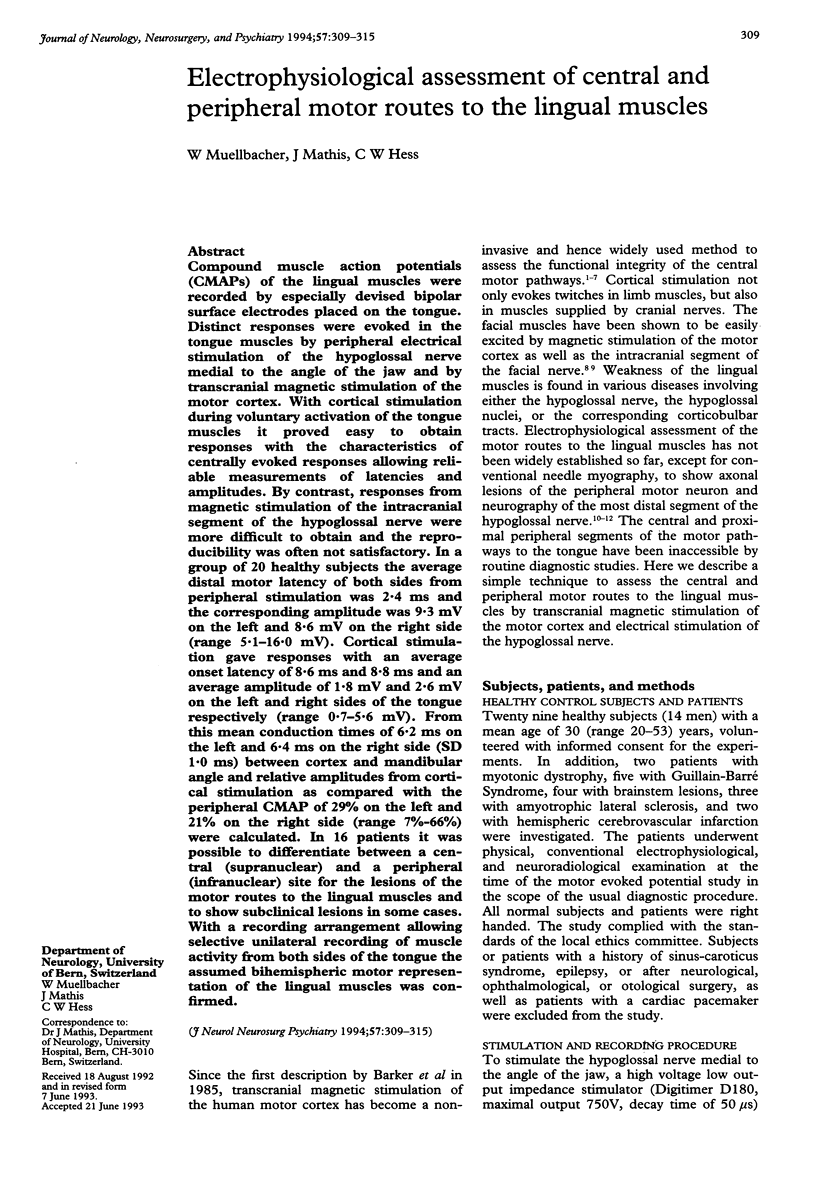

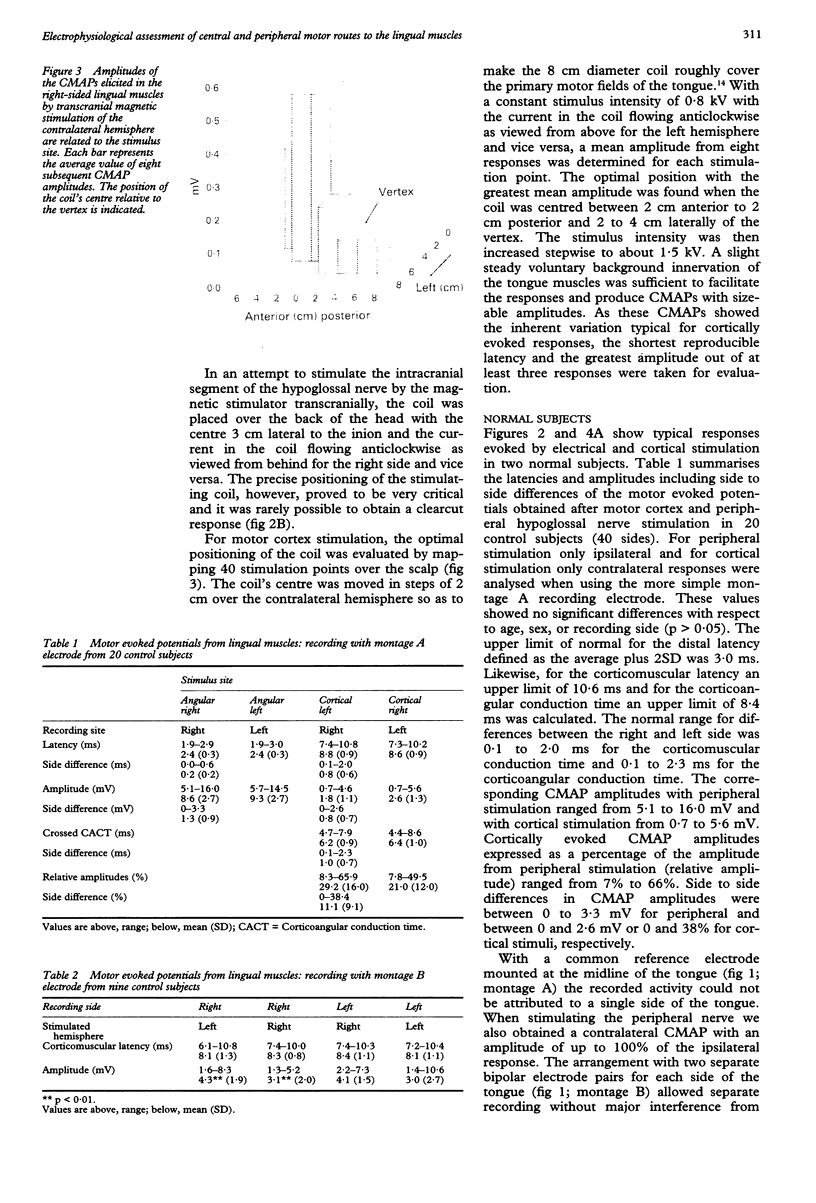
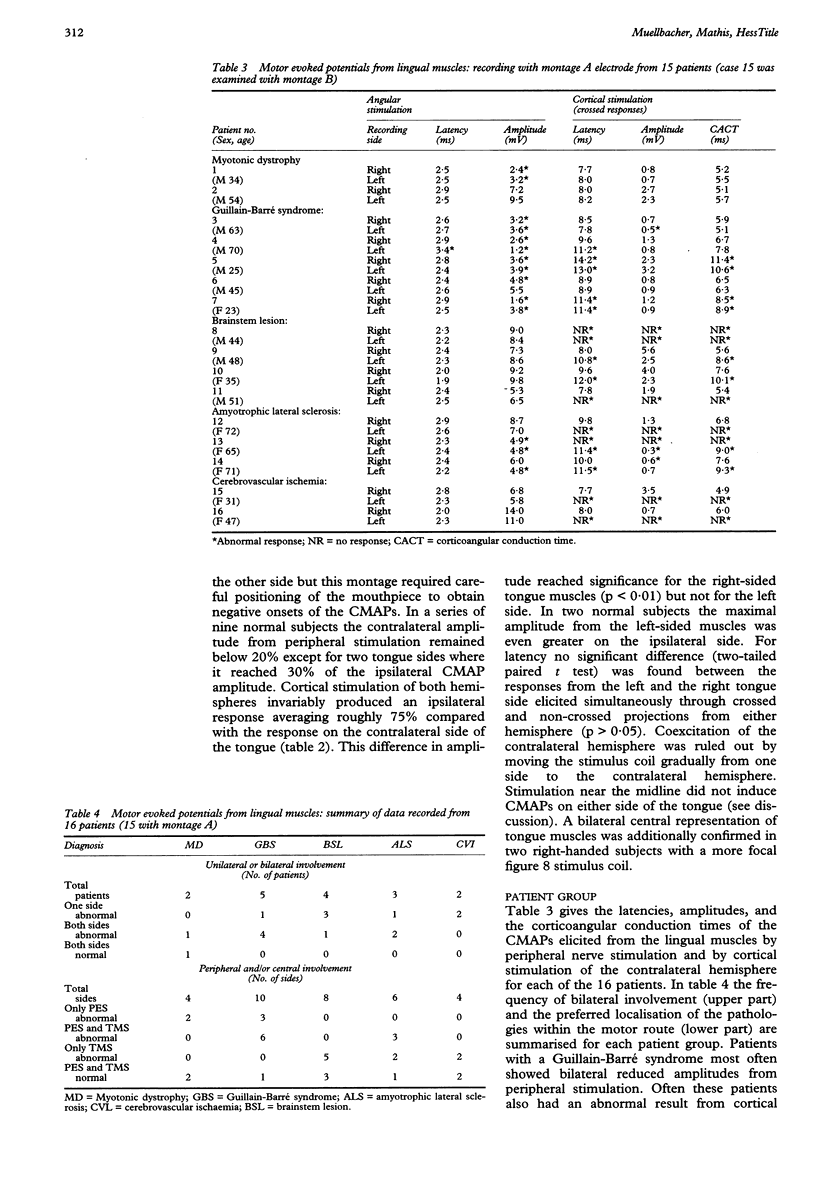
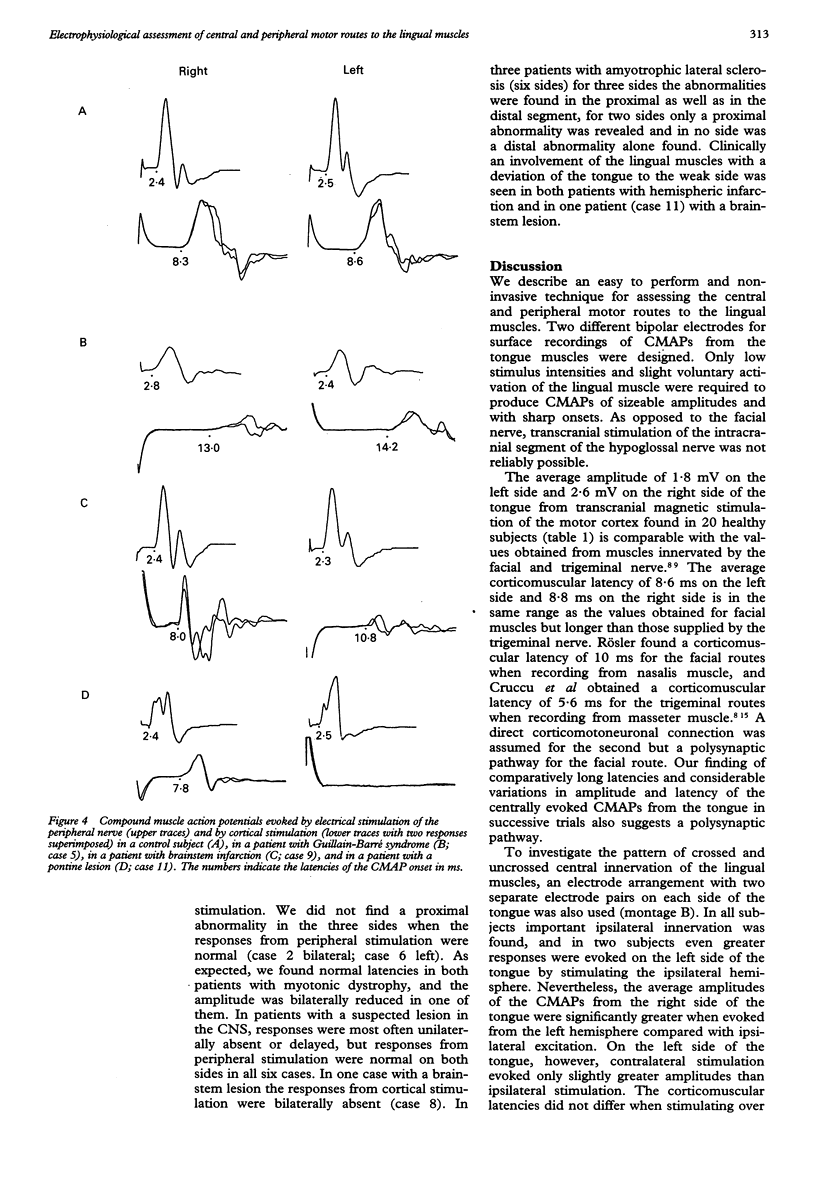
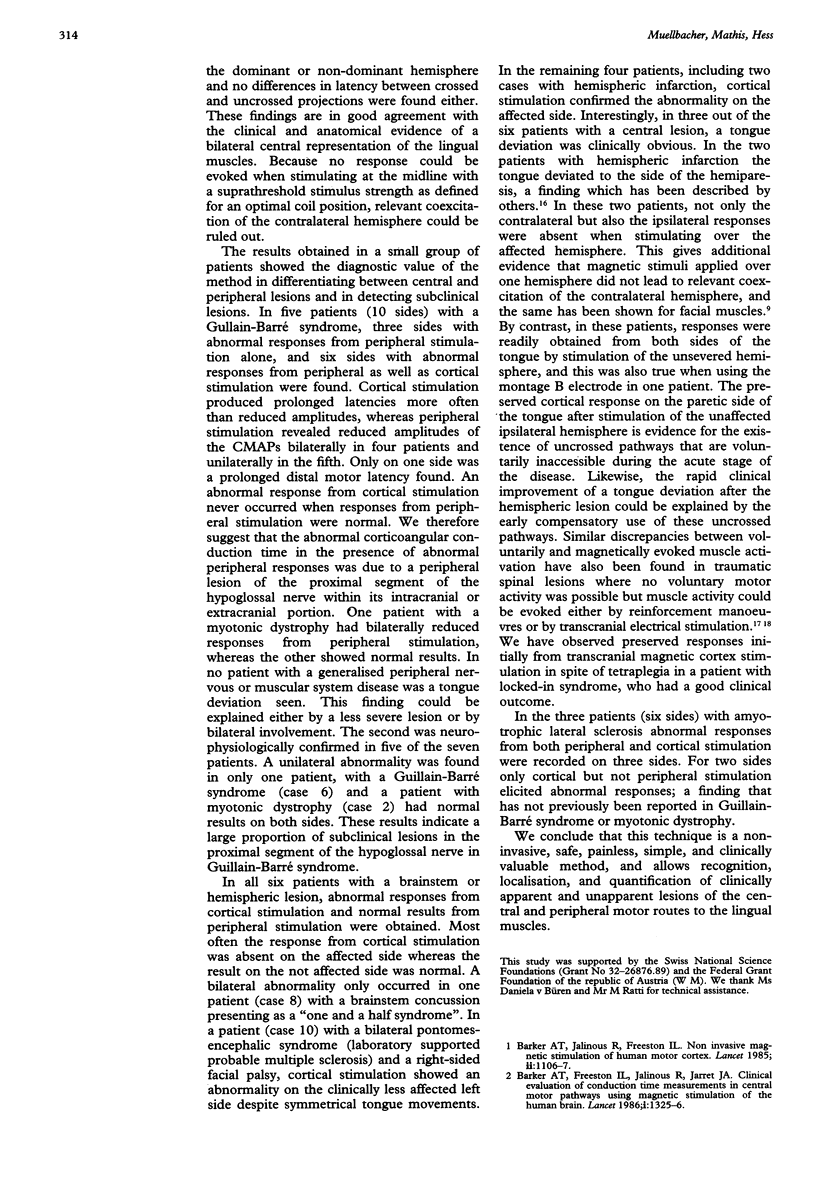
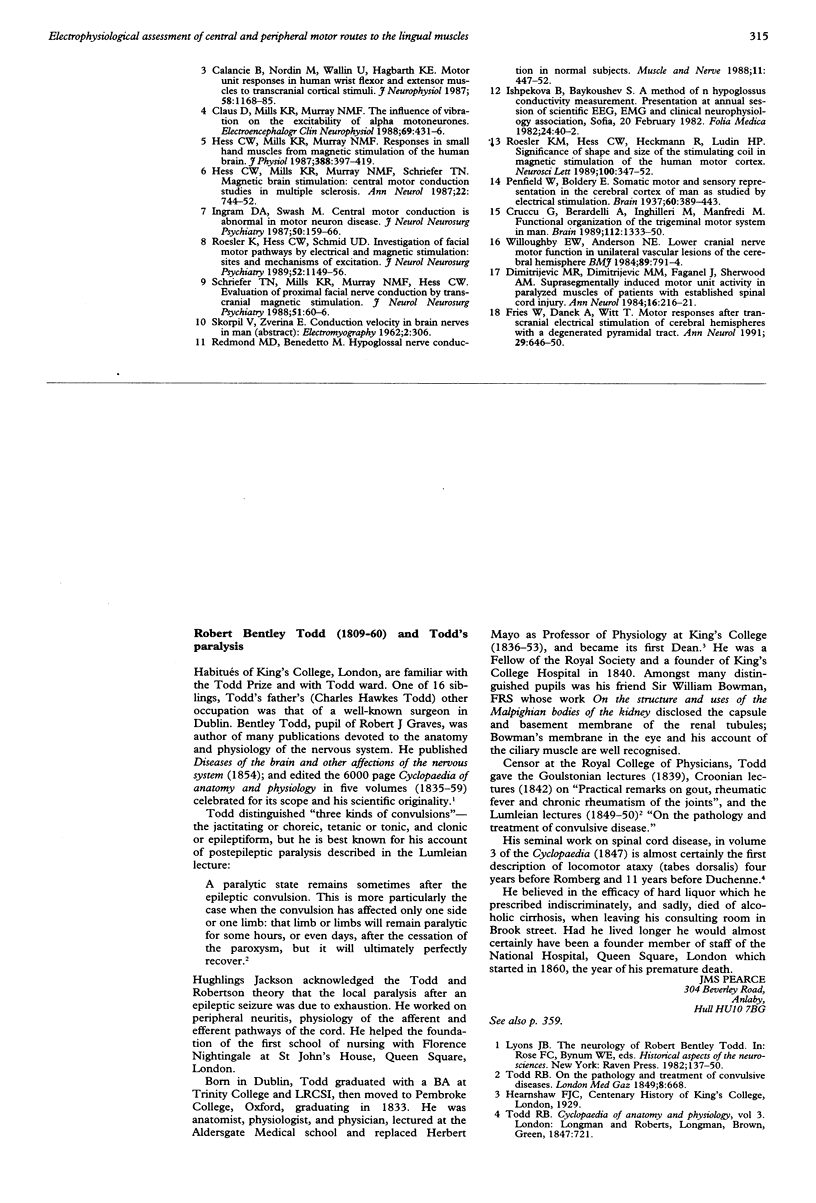
Images in this article
Selected References
These references are in PubMed. This may not be the complete list of references from this article.
- Barker A. T., Freeston I. L., Jabinous R., Jarratt J. A. Clinical evaluation of conduction time measurements in central motor pathways using magnetic stimulation of human brain. Lancet. 1986 Jun 7;1(8493):1325–1326. doi: 10.1016/s0140-6736(86)91243-2. [DOI] [PubMed] [Google Scholar]
- Calancie B., Nordin M., Wallin U., Hagbarth K. E. Motor-unit responses in human wrist flexor and extensor muscles to transcranial cortical stimuli. J Neurophysiol. 1987 Nov;58(5):1168–1185. doi: 10.1152/jn.1987.58.5.1168. [DOI] [PubMed] [Google Scholar]
- Claus D., Mills K. R., Murray N. M. The influence of vibration on the excitability of alpha motoneurones. Electroencephalogr Clin Neurophysiol. 1988 May;69(5):431–436. doi: 10.1016/0013-4694(88)90065-x. [DOI] [PubMed] [Google Scholar]
- Colombo M., Mannucci P. M., Carnelli V., Savidge G. F., Gazengel C., Schimpf K. Transmission of non-A, non-B hepatitis by heat-treated factor VIII concentrate. Lancet. 1985 Jul 6;2(8445):1–4. doi: 10.1016/s0140-6736(85)90055-8. [DOI] [PubMed] [Google Scholar]
- Cruccu G., Berardelli A., Inghilleri M., Manfredi M. Functional organization of the trigeminal motor system in man. A neurophysiological study. Brain. 1989 Oct;112(Pt 5):1333–1350. doi: 10.1093/brain/112.5.1333. [DOI] [PubMed] [Google Scholar]
- Dimitrijevic M. R., Dimitrijevic M. M., Faganel J., Sherwood A. M. Suprasegmentally induced motor unit activity in paralyzed muscles of patients with established spinal cord injury. Ann Neurol. 1984 Aug;16(2):216–221. doi: 10.1002/ana.410160208. [DOI] [PubMed] [Google Scholar]
- Fries W., Danek A., Witt T. N. Motor responses after transcranial electrical stimulation of cerebral hemispheres with a degenerated pyramidal tract. Ann Neurol. 1991 Jun;29(6):646–650. doi: 10.1002/ana.410290612. [DOI] [PubMed] [Google Scholar]
- Hess C. W., Mills K. R., Murray N. M. Responses in small hand muscles from magnetic stimulation of the human brain. J Physiol. 1987 Jul;388:397–419. doi: 10.1113/jphysiol.1987.sp016621. [DOI] [PMC free article] [PubMed] [Google Scholar]
- Hess C. W., Mills K. R., Murray N. M., Schriefer T. N. Magnetic brain stimulation: central motor conduction studies in multiple sclerosis. Ann Neurol. 1987 Dec;22(6):744–752. doi: 10.1002/ana.410220611. [DOI] [PubMed] [Google Scholar]
- Ingram D. A., Swash M. Central motor conduction is abnormal in motor neuron disease. J Neurol Neurosurg Psychiatry. 1987 Feb;50(2):159–166. doi: 10.1136/jnnp.50.2.159. [DOI] [PMC free article] [PubMed] [Google Scholar]
- Redmond M. D., Di Benedetto M. Hypoglossal nerve conduction in normal subjects. Muscle Nerve. 1988 May;11(5):447–452. doi: 10.1002/mus.880110506. [DOI] [PubMed] [Google Scholar]
- Rösler K. M., Hess C. W., Heckmann R., Ludin H. P. Significance of shape and size of the stimulating coil in magnetic stimulation of the human motor cortex. Neurosci Lett. 1989 May 22;100(1-3):347–352. doi: 10.1016/0304-3940(89)90711-8. [DOI] [PubMed] [Google Scholar]
- Rösler K. M., Hess C. W., Schmid U. D. Investigation of facial motor pathways by electrical and magnetic stimulation: sites and mechanisms of excitation. J Neurol Neurosurg Psychiatry. 1989 Oct;52(10):1149–1156. doi: 10.1136/jnnp.52.10.1149. [DOI] [PMC free article] [PubMed] [Google Scholar]
- Schriefer T. N., Mills K. R., Murray N. M., Hess C. W. Evaluation of proximal facial nerve conduction by transcranial magnetic stimulation. J Neurol Neurosurg Psychiatry. 1988 Jan;51(1):60–66. doi: 10.1136/jnnp.51.1.60. [DOI] [PMC free article] [PubMed] [Google Scholar]
- Willoughby E. W., Anderson N. E. Lower cranial nerve motor function in unilateral vascular lesions of the cerebral hemisphere. Br Med J (Clin Res Ed) 1984 Sep 29;289(6448):791–794. doi: 10.1136/bmj.289.6448.791. [DOI] [PMC free article] [PubMed] [Google Scholar]




